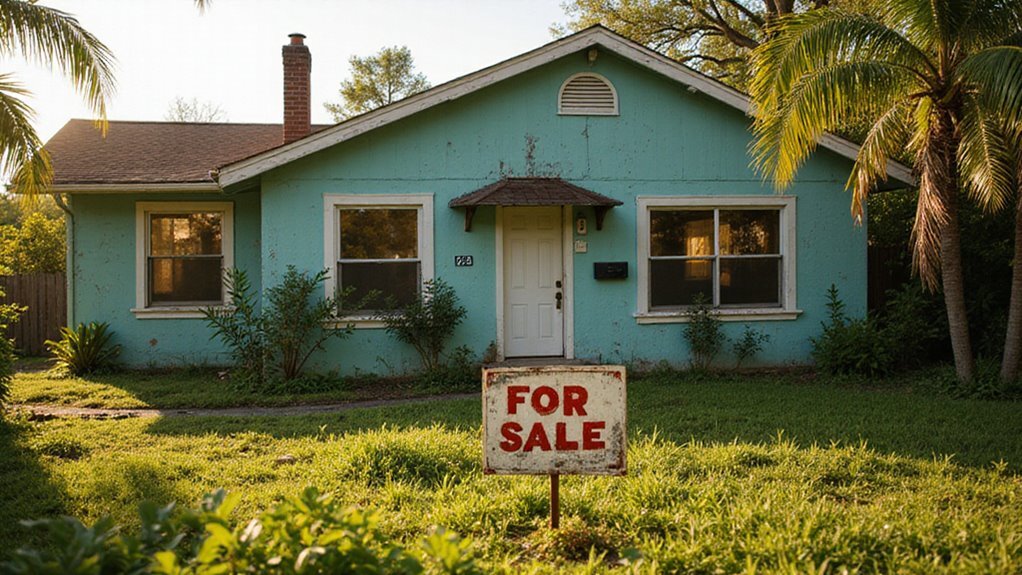Selling your home can be a tough choice with many factors to weigh. Should you sell as-is or opt for a traditional sale? The decision affects your time, effort, and money. It’s a big step that needs careful thought to avoid stress and loss. But the pressure doesn’t stop there.
Choosing wrong might mean losing money or wasting time on repairs. Delays can frustrate you, and unexpected costs can pile up. The wrong path could leave you regretting your decision. Yet, there’s a way to make this easier.
Selling as-is offers speed, while traditional sales often bring higher profits. By understanding both options, you can pick what fits your needs. This clarity helps you sell confidently and smartly. This blog will guide you through both methods to solve your home-selling dilemma effectively.
Key Takeaways
- Selling as-is means no repairs by the seller, unlike traditional sales where fixes enhance appeal.
- As-is sales attract cash buyers and investors, while traditional sales draw wider buyer interest.
- As-is offers faster closings with fewer negotiations compared to the lengthy traditional process.
- Traditional sales often yield higher prices through staging, unlike lower-priced as-is sales.
- As-is sales risk hidden issues, whereas traditional sales involve structured agent guidance.
What Is As-Is Home Sale?

An “as-is” home sale means buying a property in its present condition. The seller won’t make any repairs before closing. As a buyer, you accept all flaws, seen or unseen. You can’t ask the seller to fix issues. If you proceed, a thorough inspection is essential.
Exploring its history, “as-is” sales come from old legal practices. They follow the “buyer beware” principle. This means you take full responsibility for the home’s state. If problems arise, the seller isn’t liable. Always assess the property carefully before deciding. Sellers often choose this option to achieve a faster sales process without the burden of costly repairs.
Key Features of As-Is Home Sale
When you opt for an as-is home sale, you’re looking at key benefits like a fair price, cash offers, and a faster sale. You’ll also appreciate the simplified process that cuts through much of the red tape, saving you time and effort. Keep in mind, though, that your buyer pool might be limited due to the property’s condition. Additionally, this approach often eliminates the need for costly repairs or renovations, allowing you to sell without investing extra money or time.
Fair Price
Determining a fair price for an as-is home sale starts with knowing your property’s true worth. Look at similar homes nearby to understand local market trends. Check their conditions and locations to set a realistic price range. If comparable sales are low, expect to adjust your expectations accordingly.
A detailed market analysis helps you gauge what buyers might pay for similar properties. Use appraisal methods to evaluate your home objectively, even with flaws. Factor in repairs or outdated features that could lower the value. If issues are major, buyers will likely demand a discount.
Avoid overpricing, as as-is homes carry risks for buyers. Set a competitive price that reflects your home’s real condition. This approach attracts serious buyers without undervaluing your property. If priced right, your home should generate genuine interest.
Cash Offer
A cash offer speeds up your as-is home sale by avoiding long waits. Buyers have ready funds, so there’s no delay from financing issues. If you choose this, transactions become smoother and faster. Consider tax impacts and consult a professional about capital gains or deductions.
Negotiation skills can boost your cash offer significantly. Don’t take the first bid; counter with a strong stance. If possible, research similar sales to support your asking price. Stay firm on key terms to maintain control. A cash offer helps you close deals with confidence.
Faster Sale
Selling your home as-is speeds up the process, especially with a cash offer in hand. You avoid long delays common in traditional sales where buyers request repairs. Investors or quick buyers are drawn to as-is deals, reducing market timing risks. If the season isn’t ideal, you can still sell on your schedule.
As-is sales also bring advantages like faster closings with cash buyers. These buyers focus on speed and rarely negotiate or delay for inspections. You might close in just days if conditions align perfectly. By opting for this method, you control the timeline and meet urgent needs.
Simplified Process
An as-is home sale offers a simple process that saves you time and effort. You skip major repairs and staging. The property sells in its current state, reducing preparation stress. This approach speeds up the entire transaction.
Modern tools can make this even easier if you use them wisely. Automation Benefits cut down paperwork and manual tasks. Digital platforms streamline communication for a smoother experience. Good Interface Design helps you navigate systems with ease. If you manage listings well, negotiations feel user-friendly. Closing details become simple when handled through these tools. Choosing an as-is sale means prioritizing efficiency every step. You can then focus on your next plans confidently.
Limited Buyer Pool
Selling a home as-is often limits your pool of potential buyers. Many people avoid properties in poor condition. This choice narrows your market significantly from the start. If you proceed, you must understand these buyer challenges.
Consider these key reasons your buyer pool shrinks:
- Risk Concerns – Buyers often fear hidden problems in as-is homes. They worry about unexpected repair costs.
- Loan Issues – Lenders might reject loans for homes needing big fixes. This restricts many buyers.
- Investor Focus – Investors usually target as-is sales for cheap deals. Families often seek ready homes.
If you grasp these limits, you can plan a realistic as-is sale.
Reduced Contingencies
An as-is home sale offers many benefits, including reduced contingencies. This means fewer risks that delay typical sales. Buyers accept the property as it is, avoiding repair demands. If inspections reveal issues, renegotiations won’t happen. This saves sellers both time and worry.
Additionally, fewer contingencies shift responsibility to the buyer. Sellers aren’t required to fix hidden problems. If buyers want changes, they handle it themselves. This ensures a quicker closing process. Choosing an as-is sale helps sellers avoid obstacles and gain certainty.
What is the Traditional Home Selling Process?

The traditional home selling process is a structured path to sell your property. It starts when you decide to sell. You team up with a real estate agent for guidance. Together, you create a strong marketing plan to reach buyers. If challenges arise, you use smart negotiation skills to get good offers. Enhancing your property’s appeal through curb appeal strategies can significantly attract potential buyers.
Here’s a simple breakdown of key steps:
- Prepare Your Home: Fix and stage your house to attract buyers.
- Set a Price: Your agent helps find a fair market value.
- Market and Show: Promote your home to draw in potential buyers.
Key Features of Traditional Home Selling
When you opt for traditional home selling, you’re often positioned to secure a higher price, but you’ll need patience as the process can drag on. You’ll find it’s a more involved journey, requiring your active role in repairs, staging, and negotiations, while tapping into a broader buyer pool. Understand that this method demands your time and effort to attract diverse offers and maximize returns. Additionally, setting the right price by reviewing comparable home sales in your area is crucial to avoid overpricing and ensure a successful sale.
Potential for Higher Price
Traditional home sales often bring higher prices than as-is deals due to better appeal. When you choose this method, your home attracts more buyers. If you invest in repairs, the property’s value rises. Staging also helps create a strong first impression.
Here’s why this strategy works well:
- Great First Look: A neat home grabs attention and supports a higher price.
- Wider Buyer Interest: Fixing issues early draws in more potential buyers.
- Stronger Bargaining: If competition grows, you can ask for a better deal.
Slower Sale Process
Traditional home sales can bring higher profits, but they often take longer. The process might stretch over several months. Economic factors like interest rates or market demand can slow things down. If the economy weakens, buyers may hesitate to purchase. Seasonal trends also affect sales—spring and summer are busier times. In winter, fewer buyers show interest, delaying your sale. You must stay flexible since these factors are uncontrollable. If you time the market well, you might get a good offer. Otherwise, waiting for the right buyer could take longer.
More Involved Process
Traditional home selling is a detailed process, unlike the straightforward as-is method. It requires time, effort, and careful attention. If you choose this path, expect multiple steps and responsibilities before closing the deal.
Here’s what you’ll encounter in this complex journey:
- Title Search: You must check the property title for liens or disputes. If issues appear, delays could happen.
- Closing Costs: You’ll pay fees like agent commissions and legal costs. These can quickly become expensive.
- Negotiations: You might need to discuss price and terms with buyers. This can complicate the sale.
Broader Buyer Pool
Why restrict yourself to a small market when traditional home selling offers a broader buyer pool? By fixing and staging your home, you attract not just local buyers but also International Buyers. These buyers often want homes ready to move into. Traditional selling helps your listing shine on global platforms, gaining interest from abroad.
Additionally, you can connect with Diverse Demographics, like young workers or expanding families. If your home looks great, it draws people from different cultures and incomes. Don’t narrow your chances; traditional methods boost visibility. They ensure you reach many buyers ready to pay a good price.
Why Selling A House As-Is Is A Good Option

Selling your house as-is can be a smart choice if you want a quick sale. It saves you from expensive repairs and cuts down on time. This option brings ease by avoiding renovation stress. If you choose this, you might also save money for future plans.
Here’s why an as-is sale could benefit you:
- Fast Deals: Buyers take the home as it is, speeding up the process.
- Lower Expenses: You avoid spending on fixes or updates before selling.
- Less Worry: If repairs are needed, you won’t handle them yourself.
Opt for as-is to simplify your sale with little effort. Additionally, cash buyers often purchase properties requiring renovations, making the process even smoother.
Conclusion
As you consider your options, selling as-is offers a quick solution. If you avoid repairs, you save time and effort. Traditional sales, however, could bring higher profits with added work.
If speed matters, selling as-is might be best. We buy houses for cash, ensuring a fast, hassle-free process. This option suits those needing immediate results without delays.
Should you need a swift sale, we’re here to help. Contact Greg Buys Houses today for a fair, easy transaction.

